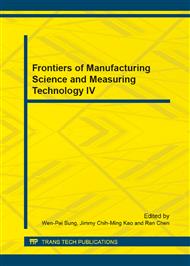[1]
Liu Y X, Liu J J, Mu L L, et al. A review of impact-crater detection (in Chinese). Astron Res Tech, 2012, 9(2): 203–212.
Google Scholar
[2]
Wan C, Cheng W M, Zhou Z P, et al. Automatic extraction of lunar impact craters from Chang'E-1 satellite photographs. Sci China-Phys, Mech Astron, 2012, 55: 162–169.
DOI: 10.1007/s11433-011-4584-6
Google Scholar
[3]
Kim J R, Muller JP, van Gasselt S, et al. Automated crater detection, a new tool for mars cartography and chronology[J]. Photogrammetric Engineering and Remote Sensing, 2005, 71(10): 1205-1217.
DOI: 10.14358/pers.71.10.1205
Google Scholar
[4]
Bandeira L P C, Saraiva J, Pina P. Development of a methodology for automated crater detection on the planetary image[M]/ Pattern Recognition and Image Analysis. Berlin: Springer, 2007: 193-200.
DOI: 10.1007/978-3-540-72847-4_26
Google Scholar
[5]
Feng JunHua, Cui HuTao, Cui PingYuan, Tian Yang, Planetary surface crater monitoring and matching methods has been propesed in ACTA AERONAUTICA ET ASTRONAUTICASINICA, (2010).
DOI: 10.1109/isscaa.2010.5633604
Google Scholar
[6]
Cheng Y, Miller J K, Autonomous landmark based spacecraft navigation system[C]/2003 AAS/AIAA Astrodynamics Specialist Conference. Ponce, Puerto Rico: (2003).
Google Scholar
[7]
Cheng Y, Miller J K, Matthies L H, et al. Optical landmark detection for spacecraft navigation[C]/13th Annual AAS/AIAA Space Flight Mechanics Meeting. Ponce, Puerto Rico: (2003).
Google Scholar
[8]
John Canny. A Computational Approach to Edge Detection [J]. IEEE Trans. Pattern Analysis and Machine Intelligence (S0162-8828) , 1986 , 8(6):679-6981999.
DOI: 10.1109/tpami.1986.4767851
Google Scholar
[9]
Wei Yi, Xu HuaZhong, An ellopse identify fast algorithm based on the theory of error. Information science and electronic engineering. 2005, 12, third volume, No 4.
Google Scholar
[10]
JIANG HongKun, TIAN XiaoLin, XU AoAo, An automatic algorithm for detecting lunar impact craters which has been proposed in a defined feature space, SCIENTIA SINICA Physica, Mechanica & Astronomica, 2013, 43(11): 1430-1437.
DOI: 10.1360/132013-321
Google Scholar


